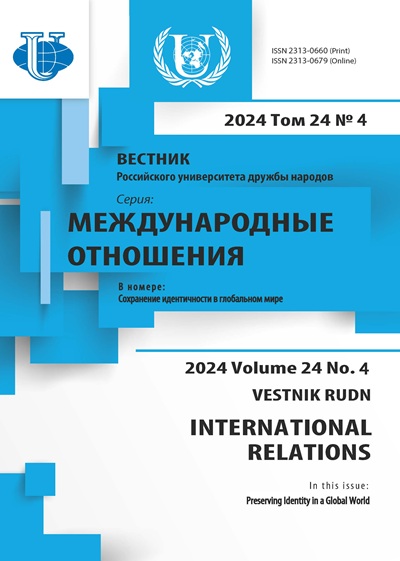CHINA’S REGIONAL INTEGRATION AGREEMENTS IN THE FRAMEWORK OF MODEL “SOUTH-SOUTH”
- Authors: Kostyunina G.M.1, Baronov V.I.2
-
Affiliations:
- Moscow State Institute of International Relations (University) of the Ministry of Foreign Affairs of Russian Federation
- Moscow Metropolitan Governance University
- Issue: Vol 18, No 3 (2018): Prospects for South—South Cooperation. 40th Anniversary of the Buenos Aires Plan of Action
- Pages: 612-627
- Section: THEMATIC DOSSIER
- URL: https://journals.rudn.ru/international-relations/article/view/20107
- DOI: https://doi.org/10.22363/2313-0660-2018-18-3-612-627
Cite item
Full Text
Abstract
The purpose of the article is to identify the foundations of China’s integration policy and the features of its integration agreements with developing countries, i.e. in the framework of the South- South model. The basis of the Chinese integration strategy is the principle of “big country morality”, which allows to assist developing countries with small territory and to a lesser extent proceed from accounting for the economic advantages of membership in an agreement (no wonder some agreements have the effect of deviating trade for the PRC). The developing countries are China's main partners in the integration agreements (12 out of 16). The article compares the norms of China's integration agreements with individual partner countries, and examines the impact of membership on Chinese foreign trade relations and identifies the most effective agreements. The main conclusions of the authors include the prevalence of the South-South model as bilateral agreements, the liberalization of trade in goods and services, the priority in signing agreements with the countries of Asia; relatively narrow scope and rarely include issues of protection of intellectual property rights, competition policy, ecology, public procurement; application of a flexible approach to the selection of partners for integration agreements and the content of agreements; more dynamic growth of China’s exports to partner countries on integration agreements; Integration agreements with ASEAN, the Republic of Korea and Pakistan became the most effective for the PRC.
About the authors
Galina Mikhailovna Kostyunina
Moscow State Institute of International Relations (University) of the Ministry of Foreign Affairs of Russian Federation
Author for correspondence.
Email: galina_kostynina@yahoo.com
Doctor of Economics, Professor, Professor of Department of International Economic Relations and Foreign Economic Relations of Moscow State Institute of International Relations (University) of the Ministry of Foreign Affairs Russian Federation
Vladimir Ivanovich Baronov
Moscow Metropolitan Governance University
Email: baronov46@mail.ru
PhD in Legal Sciences, Professor, Professor of Department of Jurisprudence of Moscow Metropolitan Governance University
References
- Baronov, V.I. & Kostyunina, G.M. (2016). Trans-Pacific Partnership: the main provisions of the agreement and the potential effect. International Affairs, 2, 90—112. (in Russian).
- Degterev, D.A., Yan, L. & Trusova, A.A. (2017). Russian and Chinese Systems of Development Cooperation: A Comparative Analysis. Vestnik RUDN. International Relations, 17(4), 824—838. DOI: http://dx.doi.org/10.22363/2313-0660-2017-17-4-824-838. (in Russian).
- Grossman, G. & Helpman, E. (1995). The politics of free trade agreements. American Economic Review, 85(4), 667—690.
- He, Fan & Yang, Panpan (2015). China’s Role in Asia’s Free Trade Agreements. Asia and the Pacific Policy Studies, 2 (2), 416—424. DOI: https://doi.org/10.1002/app5.66.
- Kostyunina, G.M. (2017). The Integration Model ASEAN+1: the Main Norms of Agreements and Effect on Foreign Economic Ties. Vestnik RUDN. International Relations, 17 (3), 441—457. DOI: http://dx.doi.org/10.22363/2313-0660-2017-17-3-441-457. (in Russian).
- Li, Chunding, Wang, Jing & Whalley, J. (2014). China’s Regional and Bilateral Trade Agreements. NBER Working Papers Series. N 19833. Cambridge. doi: 10.3386/w19853.
- Li, Yang. (2015). China’s Free Trade Agreement diplomacy. PhD Thesis. doi: 10.4225/55/ 58af695f326d2. URL: https://adelaide.edu.au/dspace/handle/2440/103486. (accessed 12.02.2018).
- Nakagawa, J. & Liang, W. (2011). A Comparison of FTA Strategies of Japan and China and their Implications for Multilateralism. RCCPB Working Paper № 11. Indiana University, Bloomington.
- Petri, P.A., Plummer, M.G. & Zhai, F. (2012). The Trans-Pacific Partnership and Asia-Pacific Integration. A Quantitative Assessment. Peterson Institute for International Economics and East— West Center Policy Analyses in International Economics. № 98. Washington DC.
- Quinn, H. (2015). Trading with a Giant. The Implications of New Zealand’s Free Trade Agreement with China. China Research Papers № 1. New Zealand Contemporary China Research Centre. Wellington.
- Revenko, L.S. (Ed.). (2017). International economic relations: pluralism of opinions in an era of change. Moscow: MGIMO-University. (in Russian).
- Salidjanova, N. (2015). China’s Trade Ambitions: Strategy and Objectives behind China’s Pursuit of Free Trade Agreements. US—China Economic and Security Review Commission. URL: https://www.uscc.gov/sites/default/files/Research/China's%20Trade%20Ambitions%20-%2005.28%2015.pdf 103486 (accessed 12.02.2018).
- Song, Guoyou & Yuan, Wenjin, (2012). China’s Free Trade Agreement Strategies. The Washington Quarterly, 35 (4), 107—119. DOI: https://doi.org/10.1080/0163660X.2012.726425.
- Understanding China’s Free Trade Agreements. China Briefing. URL: http://www.china-briefing.com/ news/2014/02/10/understanding-chinas-free-trade-agreements.html 103486 (accessed 12.02.2018).
- Wise, C. (2012). China’s Free Trade Agreements in South America. Inter-American Dialogue Economics Brief. URL: http://www.thedialogue.org/wp-content/uploads/2012/11/ChinasFree TradeAgreementsinSouthAmerica.pdf 103486 (accessed 12.02.2018).
- Zeng, Ka (2016). China’s Free Trade Agreement Diplomacy. The Chinese Journal of International Politics, 9 (3), 277—305. DOI: https://doi.org/10.1093/cjip/pow009.











